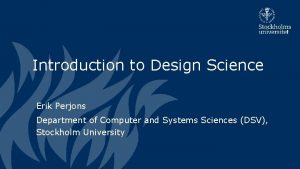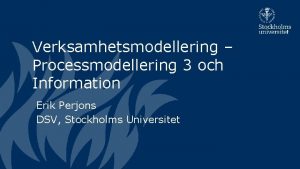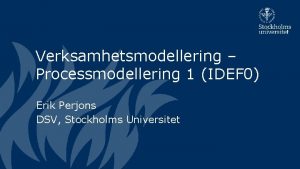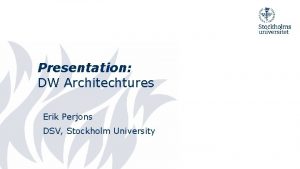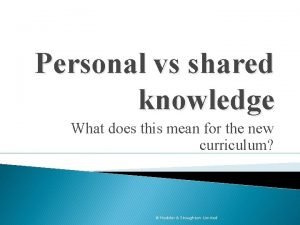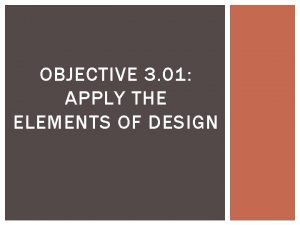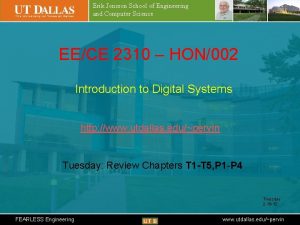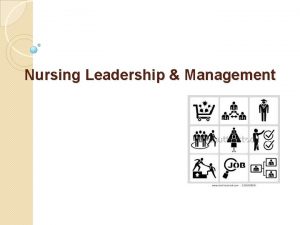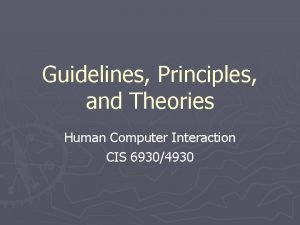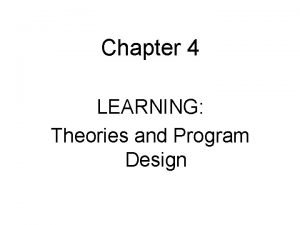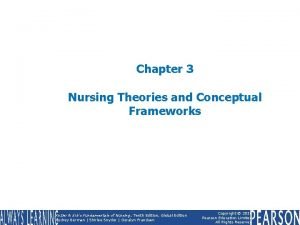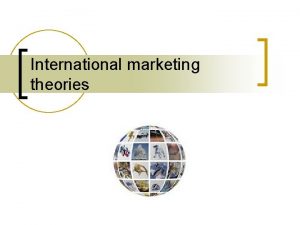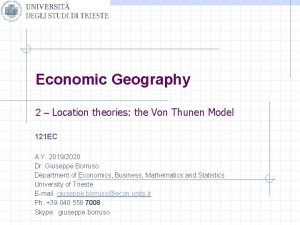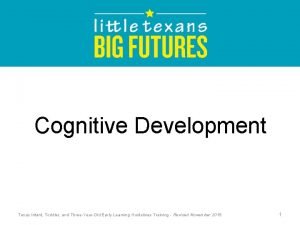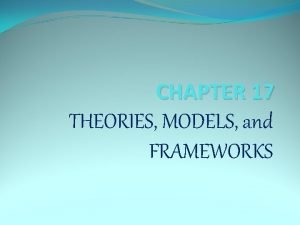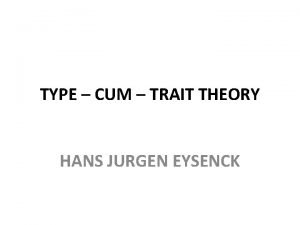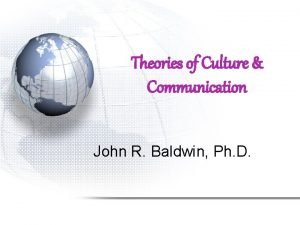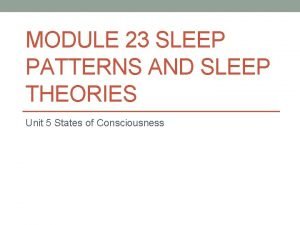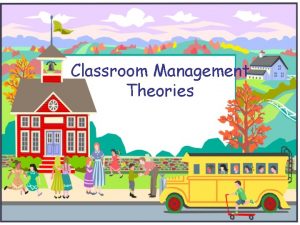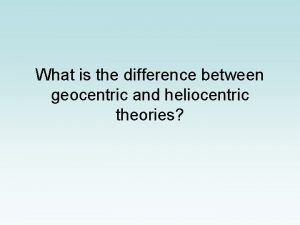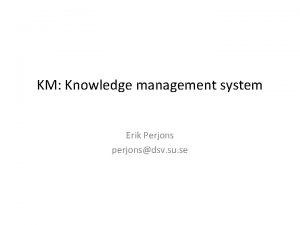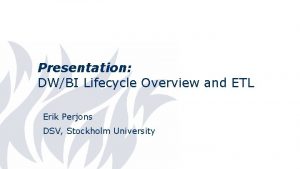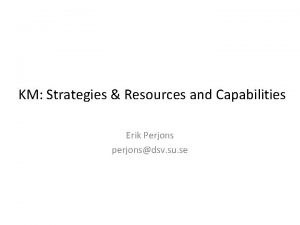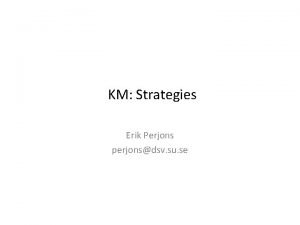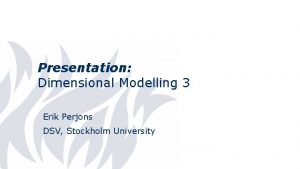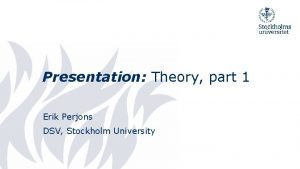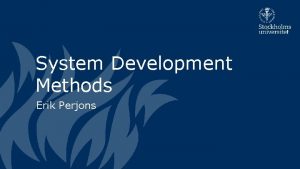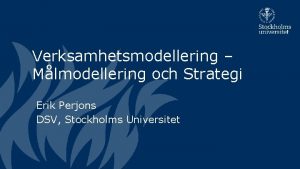Lecture 5 Theories and knowledge forms Erik Perjons



























































- Slides: 59

Lecture 5: Theories and knowledge forms Erik Perjons DSV, Stockholm University

Knowledge definitions ● Knowledge is defined as a justified belief that increases an entity's capacity for effective action (Huber 1991; Nonaka 1994). ● Knowledge has been described as "a state or fact of knowing" with knowing being a condition of "understanding gained through experience or study; [Alavi, M. and Leidner, D. E. (2001). Review: Knowledge management and knowledge management systems: Conceptual foundations and research issues. MIS Quarterly, 25, (1), 107 -136. ]

Theories ● Knowledge management has its base in literature about information technology and information systems, strategic management and organizational theory ● Organizational knowledge management [Alavi, M. and Leidner, D. E. (2001). Review: Knowledge management and knowledge management systems: Conceptual foundations and research issues. MIS Quarterly, 25, (1), 107 -136. ]

Knowledge based view of the firm ● Knowledge based theory/view/perspective of the firm has its base in ideas by Nonaka and Spender ● Knowledge based theory/view/perspective of the firm is built upon and extend the resource based view of the firm – which is based on ideas by Penrose, Wernerfelt, Barney, Conner [Alavi, M. and Leidner, D. E. (2001). Review: Knowledge management and knowledge management systems: Conceptual foundations and research issues. MIS Quarterly, 25, (1), 107 -136. ]

Knowledge based view of the firm ● The knowledge-based perspective postulates that the services rendered by tangible resources depend on how they are combined and applied, which is in turn a function of the firm's know-how (i. e. , knowledge). ● his knowledge is embedded in and carried through multiple entities including organization culture and identity, routines, policies, systems, and documents, as well as individual employees (Spender) [Alavi, M. and Leidner, D. E. (2001). Review: Knowledge management and knowledge management systems: Conceptual foundations and research issues. MIS Quarterly, 25, (1), 107 -136. ]

Knowledge based view of the firm ● Because knowledge-based resources are usually difficult to imitate and socially complex, the knowledgebased view of the firm posits that these knowledge assets may produce long-term sustainable competitive advantage. [Alavi, M. and Leidner, D. E. (2001). Review: Knowledge management and knowledge management systems: Conceptual foundations and research issues. MIS Quarterly, 25, (1), 107 -136. ]

Knowledge based view of the firm ● However, it is less the knowledge existing at any given time per se than the firm's ability to effectively apply the existing knowledge to create new knowledge and to take action that forms the basis for achieving competitive advantage from knowledge-based assets. ● It is here that information technologies may play an important role in effectuating the knowledgebased view of the firm. Advanced information technologies (e. g. , the Internet, intranets, extranets, browsers, data warehouses, data mining techniques, and software agents) can be used to systematize, enhance, and expedite large-scale intra- and inter-firm [Alavi, M. and Leidner, D. E. (2001). Review: Knowledge management and knowledge management systems: Conceptual foundations and research issues. MIS Quarterly, 25, (1), 107 -136. ] knowledge management.

Knowledge based view of the firm ● organizational and managerial practice has recently become more knowledge-focused. For example, benchmarking, knowledge audits, best practice transfer, and employee development point to the realization of the importance of organizational knowledge and intangible assets in general (Grant 1996 a, 1996 b; Spender 1996 a, 1996 b). [Alavi, M. and Leidner, D. E. (2001). Review: Knowledge management and knowledge management systems: Conceptual foundations and research issues. MIS Quarterly, 25, (1), 107 -136. ]

Knowledge types – definitions and examples Knowledge type Definition Example Tacit Knowledge is rooted in actions, experiences and involvement in a specific context Best means to dealing with a specific customer Tacit – cognitivce tacit Mental models, beliefs and viewpoints Individual beliefon causeeffect relationships Tacit – Technical tacit Know-how, crafts, skils - applicable to specific work situations Surgery skills Explicit Articulated, generalized knowledge Knowledge of major customers in a region

Knowledge types – definitions and examples Knowledge type Definition Example Individual Created by and exist in the individual Insights gained from completed projects Social/Collective Created by and inherent in collective actions of a group Norms for intergroup communication; knowledge

Knowledge types – definitions and examples Knowledge type Definition Example Declarative Know-about What drug is approapriate for an illness Procedural Know-how How to administer a particular drug

Knowledge types – definitions and examples Knowledge type Definition Example Causal Know-why Understand why the drugs work Conditional Know-when Understand when to prescribe the drug Relational Know-with Understand how the drug interact with other drugs

Knowledge types – definitions and examples Knowledge type Definition Example Pragmatic Useful knowledge for an organization Best practices Business frameworks Project experiences Engineering drawings Market reports


Knowledge processes – Alavi & Leidner ● Alavi & Leidner (2001) emphasize three knowledge activities/processes for categorizing four different types of tools Knowledge creation Knowledge storage and retrieval Knowledge transfer Knowledge application [Alavi, M. and Leidner, D. E. (2001). Review: Knowledge management and knowledge management systems: Conceptual foundations and research issues. MIS Quarterly, 25, (1), 107 -136. ]

Knowledge processes – Alavi & Leidner ● Alavi & Leidner (2001) emphasize three knowledge activities/processes for categorizing four different types of tools Knowledge creation Knowledge storage and retrieval Knowledge transfer Knowledge application - Data mining • Learning tools [Alavi, M. and Leidner, D. E. (2001). Review: Knowledge management and knowledge management systems: Conceptual foundations and research issues. MIS Quarterly, 25, (1), 107 -136. ]

Knowledge processes – Alavi & Leidner ● Alavi & Leidner (2001) emphasize three knowledge activities/processes for categorizing four different types of tools Knowledge creation Knowledge storage and retrieval Knowledge transfer Knowledge application KM systems/tools: - Data mining - Learning tools - Electronic bulletin boards - Knowledge repository - Databases - Electronic bulletin boards - Discussion forum - Knowledge directories - Expert systems IT enables: - Combining new sources of knowledge - Just in time learning - Support of individual and organizational knowledge - Inter-group knowledge access - More extensive external network - Knowledge can be applied in many locations - More rapid application of knowledge through workflow automation - More communication channels - Faster access to knowledge sources - Workflow system

Knowledge processes – Alavi & Leidner ● Alavi & Leidner (2001) emphasize three knowledge activities/processes for categorizing four different types of tools Knowledge creation Knowledge storage and retrieval Knowledge transfer Knowledge application KM systems/tools: - Data mining - Learning tools - Electronic bulletin boards - Knowledge repository - Databases - Electronic bulletin boards - Discussion forum - Knowledge directories - Expert systems IT enables: - Combining new sources of knowledge - Just in time learning - Support of individual and organizational knowledge - Inter-group knowledge access - More extensive external network - Knowledge can be applied in many locations - More rapid application of knowledge through workflow automation - More communication channels - Faster access to knowledge sources - Workflow system

Knowledge processes – Dalkir ● Dalkir (2011) emphasize three knowledge activities/processes, similar to the ones by Alavi & Leidner (2001) Knowledge capture and/or creation Update Assess Knowledge sharing and dissemination Contextualize Knowledge acquisition and appliction [Alavi, M. and Leidner, D. E. (2001). Review: Knowledge management and knowledge management systems: Conceptual foundations and research issues. MIS Quarterly, 25, (1), 107 -136. ]

Knowledge processes – Alavi & Leidner ● Knowledge capture and/or creation ● Knowledge storage and retrieval ● Knowledge acquisition and application [Alavi, M. and Leidner, D. E. (2001). Review: Knowledge management and knowledge management systems: Conceptual foundations and research issues. MIS Quarterly, 25, (1), 107 -136. ]

Knowledge processes – Alavi & Leidner ● Alavi & Leidner (2001) emphasize three knowledge activities/processes for categorizing four different types of tools Alavi & Leidner (2001) Knowledge creation Knowledge storage and retrieval Knowledge transfer Knowledge application

Comparing knowledge processes ● Comparing knowledge processes of Alavi & Leidner (2001) and Dalkir (2011) Alavi & Leidner (2001) Alavi & Leidner Knowledge storage (2001) and retrieval Knowledge sharing Dalkir (2011) and dissemination Knowledge creation Dalkir (2011) Knowledge capture and/or creation Alavi & Leidner (2001) Knowledge appliction Knowledge acquisition and appliction Dalkir (2011)

Knowledge Transfer and Knowledge Sharing

Knowledge Transfer ● Knowledge transfer is the process through which one unit (e. g. group, department or division) is affected by the experiences by another (Argote&Ingram 2000)

Knowledge Transfer ● Knowledge transfer can be complex because: – Knowledge resides in individual employees, tools, IT systems, tasks, routines, etc – Much knowledge is tacit – Problem with beliefs, assumptions, cultural norms – Misconception – Geography/Physical Distance – Internal conflicts/politics – Generation differences – Lack of incentives to share – Lack of motivation – Lack of trust – Organisational culture that prevent sharing of knowledge – Limitation in ICT – Different languages – Previous experiences [Wikipedia: Knowledge transfer] – Lack of shared social identity

Knowledge transfer vs. Knowledge sharing ● Some researchers and practitioners in knowledge management see knowledge transfer and knowledge sharing as two different concepts – other see them as synonyms (like I do) ● Knowledge transfer - typically has been used to describe the movement of knowledge between different units, divisions, or organizations rather than individuals. ● Knowledge sharing - is more frequently used by authors focusing on the individual level.

Knowledge transfer vs. Knowledge sharing ● Another distinction is based on two different views on knowledge. ● The first view see knowledge as something that can be transferred. This view often use the term “knowledge transfer”. ● The second view see knowledge as something that is constructed in a social context and which cannot be separated from the context and/or the individual. This view often use the term “knowledge sharing”.

Practices

Brown&Duguid: Balancing Act: How to Capture Knowledge without Killing it 1(4) ● Two different approaches on management: business process reengineering (BPR) and knowledge management (KM) ● BPR (process-orientation focus): is a top-down approach, focus on structured co-ordination of people and info; focus on effiency and value creation; assume that organisations compete in a predictable environments, assume that knowledge is easy to codify ● KM (practice focus): is a bottom up approach, focus on effectiveness before effiency, assume that value creating activity are hard to pin down; assume that organisations compete in a unpredictable environments, assume that managers can best foster knowledge by responding to the inventive, improvisional ways people actually get things done

Brown&Duguid: Balancing Act: How to Capture Knowledge without Killing it 2(4) ● Managing the dilemma or organisational tension: – – ● Balancing process and practice. – – ● processes, the ways things are formally organised - and practice, the way things are actually get done If you lean too much towards practices: new ideas is bubbling up all the time, but there is a lack of structure for harnessing them. If you lean too much towards processes: you will get a lot of structure but little freedom of movement including the creation of innovation How did we solve the dilemma previously: ? Foster invention and creativity among elite workers (designers, researchers) and force the rest to work according to predictable processes. ● How will we solve the dilemma today when the environment are changing fast and constantly? Involve routine workers in the foster of invention and creativity

Brown&Duguid: Balancing Act: How to Capture Knowledge without Killing it 3(4) ● Practices. A number of small best practices, such as workarounds, local solutions. Together, this is a large amount of knowledge ● Identify which practices exist and dissiminate valuable ones. Important to learn which practices exists and dissiminate practices that are valuable in an organisation ● Hard to identify these pratices. Gap between process manuals and actions in reality and gap betwen what people think what they are doing and what they are doing i reality. ● How to identify practices: Observe the practices in reality otherwise the tacit knowledge is missed

Brown&Duguid: Balancing Act: How. Example: to Capture Knowledge without Killing it 4(4) ● Xerox service reps do something else compared to what they are expected to do. They address problem by doing things not specified in process decriptions. ● Reps meets informally, for exampel during lunch, and share knowledge about different machines, ways of workings, issues, methods used. ● Each copy machine has its own history, issues, subsystems, used in differnt ways in different environments. ● The reps have created a community of practice that develop a collective pool of practical knowledge

Work Practices Adler and Pouliot (2011) discuss the notion of practice and differentiate between behavior, action and practice: ● Behavior - is someone doing something ● Actions - are behavior with meaning to someone ● Practice - are actions repeated over time and space embedded in a particular context. Practice are socially developed through learning and training

Work Practices Adler and Pouliot (2011) present five characteristics of a practice: ● practice is performance, i. e. the process of doing something, ● practice tends to be patterned, i. e. actions are repeated over time and space, ● practice is more or less competent in the meaning that it can be done correctly or incorrectly (in a social recognizable way), ● practice rests on background knowledge

Best Practices – way of transfering/sharing knowledge

Best practices ● A best practice - is a method or technique that provides an effective means for achieving a goal in a certain context compared to other means (Veselý, 2011) ● Example of best practice methods are: ITIL, Process descriptions in Enterprise Systems such as SAP, many procedures in health care

Best, Recommended, Good or Contextual Practices ● A best practice cannot be best in all cases. Therefore, the terms “recommended practices” and “good practices” are often used instead ● A practice that is considered as "best" in one context may be questionable within another. ● That is, the notion of what is "best" will vary with the context, according to Scott Ambler, which recommend the use of the term "contextual practice“ instead

Validation of Practices ● U. S. Department of Health and Human Services uses the following terms and their definitions for how validated a practice is: ● Promising Practice - A program, activity or strategy that has worked within one organization and shows promise during its early stages ● Field Tested Best Practice - A program, activity or strategy that produce successful outcomes and is supported by data sources ● Research Validated Best Practice - A program,

Template for documenting best practices Best practices are usually described in form of a template (also called pattern), with predefined elements. Common elements are: – – – – problem that the best practice address, step-by-step description of the best practice (it is usually a procedure/method) expected result of the best practice, area/field/domain in which the best practice is to be applied, in which context/situations the best practice is relevant or not, estimation of time and cost to implement the best practice, target users/roles for applying the best practices, required skills of users/roles applying the best practices,

How to Succeed Implementing Best Practices ● There are many both successful and non-successful applications of best practices in organisations. ● Factors that may impact the success of implementing best practice are often called critical success factors for implementing best practices ● Factors that may impact the success of implementing best practices within organizations are: – – organizational culture that support or not support knowledge sharing in an organisation, the engagement, or non-engagement, of the executives and/or management of an organisation for implementing best practices. low quality of the best practice documentation …

Szulanski&Winter: Getting it Right the Second Time 1 (3) ● A majority of attempts to replicate excellence (such as best practices, good solutions) fails ● Why problem to replicate/reproduce good solutions/best practices? - It is hard to understand how different components of complex best practices are intervowen, that is, it is easy to miss important nuances of the best practices. - Employees may not understand the best practices including why the best practices are better then other solutions

Szulanski&Winter: Getting it Right the Second Time 2(3) ● How do copy a best practice? – Replicate best practices as close as possible (copy exactly). Then you will not miss important relations and nuances between the components of the best practices. You have a best practice that has worked effective in one situation, and by copy exactly you will be able to compare the copy with the original – Observe the best practices carried out in environment you copied from if possble. This increases your understanding of the best practices. It will be working example that you always can return to – …

Szulanski&Winter: Getting it Right the Second Time 3(3) ● How do copy a best practice? – … – Do not trust individuals in interviews and documentations too much. Not even the individuals that created och used the best practices may understands the complex relationships between the components of the best pratcices. People overestimate their own knowledge, understanding and skills – Replicate first and adapt later. Ensure that you achieved good results before adapting/changing the best practice. However, sometimes you need to adapt the best practices because the environments are so different

Other ways to transfer/share knowledge

Communities of Practices (Co. P) ● Community of practices (Co. P) - is a group of individuals participating in communal activity, and experiencing/continuously creating their shared identity through engaging in and contributing to the practices of their communities (Wenger, 2002) ● This can be seen as another knowledge form: Knowledge embedded in communities

Communities of Practices (Co. P) ● Co. P have been shown beneficial for the performance of the organization (Lesser&Stock, 2001) – – – ● Co. P may create new product ideas Co. P may create new way of working, Co. P may reduce rework, Co. P may support more rapidly responds to customer needs, Co. P may decrease the learning curve for new employees Co. P can exist online, using newsgroups and social media applications, or in real life, such as in a lunch room at work, in a field setting, on a plant floor, or elsewhere in the environment

Communities of Practices (Co. P) ● Co. P could be understood by compare it to: – Project teams – Community of Interest

Projects teams vs Co. P Project teams: ● A project team have shared goals, milestones and results ● A project team is driven by deliverables ● The project team members will often remain consistent in their roles during the project [Kietzmann et al, 2013] ● A project team dissolves after the mission of the project is accomplished

Projects teams vs Co. P Community of Practices (Co. P): ● A Co. P is often organically created – it can emerge without any formal decision ● The members have oftens different personal objectives instead of explicitly stated ones for the Co. P ● Membership is defined by the knowledge of the members ● Co. P membership and the members’ roles changes when needs and interests change ● [Kietzmann et al, 2013] Co. P exists as long as members believe they have something to gain from and contribute to the community

Community of Interest vs Co. P Community of Interest (Co. I): ● A Co. I is a group of people interesting in discussing a topic and share information in a topic that interest them ● The members are not necessary experts or practitioners of the topic around which the Co. I has been formed [Wikipedia: Community of practices]

Community of Interest vs Co. P Community of Practices (Co. P): ● A Co. P is a group of people of who are active practitioners ● The purpose of Co. P is to share tips and best practices between collegues, ask questions, provide support to each other ● Membership is dependent on expertise ● A Co. P participation is not approriate for non- practitioners [Wikipedia: Community of practices]

Other ways to transfer/share knowledge ● Mentoring - is a relationship in which a more experienced or more knowledgeable person helps to guide a less experienced or less knowledgeable person. The person in receipt of mentorship may be referred to as a protégé (male)/protégée (female), an apprentice. ● Apprenticeships - is a system of training a new generation of practitioners/ apprentices of a profession, often in order for the practitioners/ apprentices to get a license to practice in the profession. Most of their training is done while working with an expert that helps the apprentices learn the profession during a pre-defined time period. Apprenticeships typically last 3 to 6 years.

Other ways to transfer/share knowledge ● Pair design - is based on the agile practice of pair programming, and is a way of working in which two designers work together and simultaneously develop an artefact. Typically, one designer makes a design decision, e. g. introduces an activity into a method, and the other designer immediately reviews it and suggests possible improvements or potential problems. ● Storytelling - is a means for sharing and interpreting experiences by telling stories. Stories are universal in that

Other ways to transfer/share knowledge ● Simulation - is the imitation of the operation of a real-world process or system over time. First a model represent the real-world process or system has to be developed. Then a simulation is executed using the model representing the operation of the real-world process or system over time. ● Work shadowing - is a on-the-job learning method where an employee follow another in his/her practice to learn different aspects related to the job,

Critical Success Factors

Critical Success Factor (CSF) ● A critical success factor (CSF) - is a factor/element (i. e. an organizational structure, artifact, social relationship, process/activity/action) required for ensuring the success of an organization or a project. ● CSFs must be given special and continual attention in order to bring about success.

Critical Success Factor (CSF) Examples of CSF: – successful IT project requires user participation – successful BI project requires an installation of a BI excellence center – successful change management project requires top management support

Barriers

Barrier ● A barrier - is a constraints or factor that inhibit some preferable state, such as business IT alignment or innovation, e. g. lack of time and funding, lack of communication
 Processhanteringssystem
Processhanteringssystem Erik perjons
Erik perjons Stipulativ
Stipulativ Dsv mening
Dsv mening Målmodell
Målmodell Dsv stockholm university
Dsv stockholm university 01:640:244 lecture notes - lecture 15: plat, idah, farad
01:640:244 lecture notes - lecture 15: plat, idah, farad Knowledge creation and knowledge architecture
Knowledge creation and knowledge architecture Short form i am not
Short form i am not Strong and weak forms
Strong and weak forms Shared knowledge vs personal knowledge
Shared knowledge vs personal knowledge Knowledge shared is knowledge squared
Knowledge shared is knowledge squared Knowledge shared is knowledge multiplied meaning
Knowledge shared is knowledge multiplied meaning Contoh shallow knowledge dan deep knowledge
Contoh shallow knowledge dan deep knowledge Synthetic a posteriori
Synthetic a posteriori Book smarts vs street smarts
Book smarts vs street smarts Shared knowledge vs personal knowledge
Shared knowledge vs personal knowledge Gertler econ
Gertler econ Verb form of knowledge
Verb form of knowledge Why are related forms more agreeable than unrelated forms?
Why are related forms more agreeable than unrelated forms? Why are related forms more agreeable than unrelated forms
Why are related forms more agreeable than unrelated forms Why are related forms more agreeable than unrelated forms?
Why are related forms more agreeable than unrelated forms? Erik jonsson school of engineering and computer science
Erik jonsson school of engineering and computer science Erikson stage
Erikson stage Erik jonsson school of engineering and computer science
Erik jonsson school of engineering and computer science Utd erik jonsson school of engineering
Utd erik jonsson school of engineering Theories and values of positive practice
Theories and values of positive practice Principles of human growth and development
Principles of human growth and development Leadership grid
Leadership grid Molecular geometry and bonding theories
Molecular geometry and bonding theories Oedipus complex and electra complex
Oedipus complex and electra complex Permit easy reversal of actions
Permit easy reversal of actions Child development principles and theories
Child development principles and theories Chapter 6 - theories of international trade and investment
Chapter 6 - theories of international trade and investment Learning theories and program design
Learning theories and program design Nursing theories and conceptual frameworks
Nursing theories and conceptual frameworks Chomsky vs vygotsky
Chomsky vs vygotsky Theories of international marketing
Theories of international marketing Industrial location theories and models
Industrial location theories and models The communication cycle in health and social care
The communication cycle in health and social care Piagetian and information processing theories 8-18 months
Piagetian and information processing theories 8-18 months Nursing informatics theories, models and frameworks
Nursing informatics theories, models and frameworks Social strain theory
Social strain theory Trait theory hans eysenck
Trait theory hans eysenck Co culture definition communication
Co culture definition communication Module 23 sleep patterns and sleep theories
Module 23 sleep patterns and sleep theories Ch6n lewis structure
Ch6n lewis structure Rimland theroy
Rimland theroy Theories of normal and abnormal development
Theories of normal and abnormal development Theories of international trade and investment
Theories of international trade and investment Theories of communication in health and social care
Theories of communication in health and social care Ginott model
Ginott model Compare geocentric and heliocentric
Compare geocentric and heliocentric Colour design: theories and applications
Colour design: theories and applications Management models and theories
Management models and theories Definition of interpersonal attraction
Definition of interpersonal attraction Education theorists and their theories
Education theorists and their theories Module 23 sleep patterns and sleep theories
Module 23 sleep patterns and sleep theories Module 23 sleep patterns and sleep theories
Module 23 sleep patterns and sleep theories Electron geometry vs molecular geometry
Electron geometry vs molecular geometry

